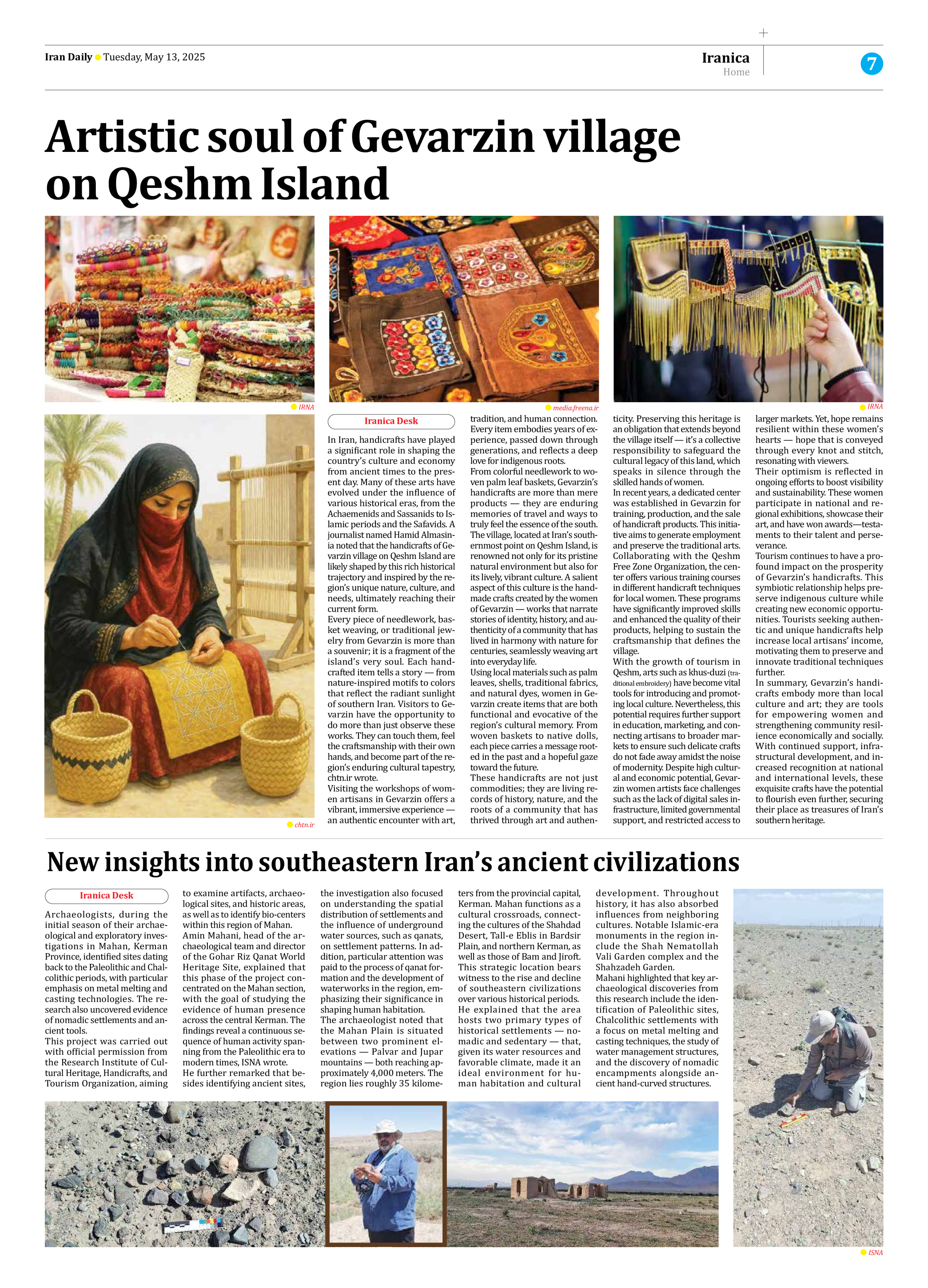
Artistic soul of Gevarzin village on Qeshm Island
In Iran, handicrafts have played a significant role in shaping the country’s culture and economy from ancient times to the present day. Many of these arts have evolved under the influence of various historical eras, from the Achaemenids and Sassanids to Islamic periods and the Safavids. A journalist named Hamid Almasinia noted that the handicrafts of Gevarzin village on Qeshm Island are likely shaped by this rich historical trajectory and inspired by the region’s unique nature, culture, and needs, ultimately reaching their current form.
Every piece of needlework, basket weaving, or traditional jewelry from Gevarzin is more than a souvenir; it is a fragment of the island’s very soul. Each handcrafted item tells a story — from nature-inspired motifs to colors that reflect the radiant sunlight of southern Iran. Visitors to Gevarzin have the opportunity to do more than just observe these works. They can touch them, feel the craftsmanship with their own hands, and become part of the region’s enduring cultural tapestry, chtn.ir wrote.
Visiting the workshops of women artisans in Gevarzin offers a vibrant, immersive experience — an authentic encounter with art, tradition, and human connection. Every item embodies years of experience, passed down through generations, and reflects a deep love for indigenous roots.
From colorful needlework to woven palm leaf baskets, Gevarzin’s handicrafts are more than mere products — they are enduring memories of travel and ways to truly feel the essence of the south. The village, located at Iran’s southernmost point on Qeshm Island, is renowned not only for its pristine natural environment but also for its lively, vibrant culture. A salient aspect of this culture is the handmade crafts created by the women of Gevarzin — works that narrate stories of identity, history, and authenticity of a community that has lived in harmony with nature for centuries, seamlessly weaving art into everyday life.
Using local materials such as palm leaves, shells, traditional fabrics, and natural dyes, women in Gevarzin create items that are both functional and evocative of the region’s cultural memory. From woven baskets to native dolls, each piece carries a message rooted in the past and a hopeful gaze toward the future.
These handicrafts are not just commodities; they are living records of history, nature, and the roots of a community that has thrived through art and authenticity. Preserving this heritage is an obligation that extends beyond the village itself — it’s a collective responsibility to safeguard the cultural legacy of this land, which speaks in silence through the skilled hands of women.
In recent years, a dedicated center was established in Gevarzin for training, production, and the sale of handicraft products. This initiative aims to generate employment and preserve the traditional arts. Collaborating with the Qeshm Free Zone Organization, the center offers various training courses in different handicraft techniques for local women. These programs have significantly improved skills and enhanced the quality of their products, helping to sustain the craftsmanship that defines the village.
With the growth of tourism in Qeshm, arts such as khus-duzi (traditional embroidery) have become vital tools for introducing and promoting local culture. Nevertheless, this potential requires further support in education, marketing, and connecting artisans to broader markets to ensure such delicate crafts do not fade away amidst the noise of modernity. Despite high cultural and economic potential, Gevarzin women artists face challenges such as the lack of digital sales infrastructure, limited governmental support, and restricted access to larger markets. Yet, hope remains resilient within these women’s hearts — hope that is conveyed through every knot and stitch, resonating with viewers.
Their optimism is reflected in ongoing efforts to boost visibility and sustainability. These women participate in national and regional exhibitions, showcase their art, and have won awards—testaments to their talent and perseverance.
Tourism continues to have a profound impact on the prosperity of Gevarzin’s handicrafts. This symbiotic relationship helps preserve indigenous culture while creating new economic opportunities. Tourists seeking authentic and unique handicrafts help increase local artisans’ income, motivating them to preserve and innovate traditional techniques further.
In summary, Gevarzin’s handicrafts embody more than local culture and art; they are tools for empowering women and strengthening community resilience economically and socially. With continued support, infrastructural development, and increased recognition at national and international levels, these exquisite crafts have the potential to flourish even further, securing their place as treasures of Iran’s southern heritage.







